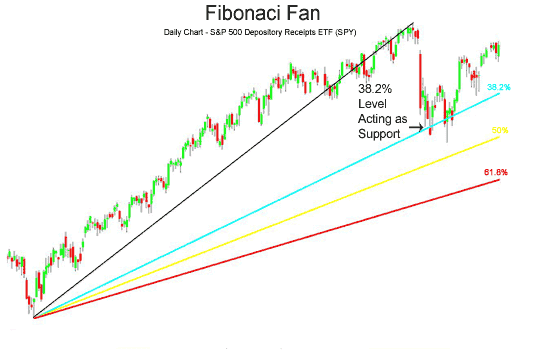Forex Trading Strategies for Using the Fibonacci Fan: Techniques for Trading with the Fibonacci Fan Tool
In the fast-paced world of forex trading, where decisions are made in split seconds and market dynamics can change in a heartbeat, traders are constantly on the lookout for reliable tools that can help them make informed decisions. One such tool that has gained popularity among forex traders is the Fibonacci Fan. Derived from the famous Fibonacci sequence, the Fibonacci Fan is a powerful technical analysis tool that aids traders in identifying potential price reversal points, trend continuation, and support and resistance levels. In this article, we will delve into the intricacies of the Fibonacci Fan and explore effective strategies for integrating it into your forex trading arsenal.
Table content
I. Understanding the Fibonacci Fan
II. Trading Strategies with the Fibonacci Fan
1. Fan Line Confluence Strategy
2. Fibonacci Fan Bounce Strategy
3. Fan Line Breakout Strategy
4. Combining Fibonacci Fans with Other Tools
5. Timeframe and Trend Alignment
III. Risk Management and Limitations
IV. Footnote
Understanding the Fibonacci Fan:
The Fibonacci Fan is a visual representation of key support and resistance levels based on Fibonacci ratios. These ratios are derived from the Fibonacci sequence, a mathematical pattern in which each number is the sum of the two preceding ones (0, 1, 1, 2, 3, 5, 8, and so on). The Fibonacci ratios most commonly used in trading are 38.2%, 50%, and 61.8%, which are believed to reflect potential retracement levels during a trend.

To draw a Fibonacci Fan, a trader selects a significant high and low point on the price chart, representing the start and end of a trend. The tool then automatically draws diagonal trendlines from the high or low point, extending at the aforementioned Fibonacci ratios. These trendlines form a fan-like pattern that intersects with the current price action, indicating potential support and resistance levels.
Trading Strategies with the Fibonacci Fan:
1. Fan Line Confluence Strategy: This strategy involves looking for confluences between Fibonacci Fan lines and other technical indicators or chart patterns. For instance, if a Fibonacci Fan's 61.8% line coincides with a horizontal support level or a trendline from another technical tool, it strengthens the potential significance of that level. Traders can then use this confluence to make more confident trading decisions, such as entering a trade or setting stop-loss and take-profit levels.
2. Fibonacci Fan Bounce Strategy: In this strategy, traders focus on identifying potential bounce areas where the price might react to a Fibonacci Fan level. When the price approaches a Fibonacci Fan line and shows signs of reversing, such as a bullish or bearish candlestick pattern, it could signal a possible entry point for a trade in the direction of the bounce. This strategy is particularly useful for traders who prefer to trade reversals rather than trend continuations.
3. Fan Line Breakout Strategy: Traders using this strategy watch for situations where the price breaks through a Fibonacci Fan level. A breakout through a key fan line could signify the continuation of the prevailing trend. Traders can place entry orders above or below the breakout level, accompanied by appropriate risk management measures. This strategy aligns well with the principle of "buying high" during an uptrend or "selling low" during a downtrend.
4. Combining Fibonacci Fans with Other Tools: For enhanced accuracy, traders often combine Fibonacci Fans with other technical analysis tools. For instance, pairing the Fibonacci Fan with trendlines, moving averages, or oscillators can provide a more comprehensive view of the market's dynamics. When multiple tools point to the same price level, it increases the likelihood of that level acting as a strong support or resistance area.
5. Timeframe and Trend Alignment: To optimize the effectiveness of the Fibonacci Fan, it's essential to align its use with the timeframe of your trading strategy. If you're a short-term trader, focus on shorter timeframes like 15 minutes or 1 hour. For longer-term strategies, consider daily or weekly charts. Additionally, ensure that the trend direction aligns with the trend indicated by the Fibonacci Fan. Trading in the direction of the prevailing trend increases the probability of successful trades.
Risk Management and Limitations:
While the Fibonacci Fan is a valuable tool, it's important to note that no strategy is foolproof. Traders should exercise caution and incorporate effective risk management practices. Setting appropriate stop-loss orders and position sizes can mitigate potential losses. Additionally, the effectiveness of the Fibonacci Fan can vary in different market conditions, and false signals can occur. Therefore, it's wise to validate its signals with other technical tools and fundamental analysis.
Footnote:
The Fibonacci Fan is a versatile tool that offers traders insights into potential support and resistance levels, aiding in the identification of trading opportunities. By integrating this tool into various trading strategies, traders can enhance their decision-making process and potentially increase their profitability. Remember that successful trading requires a combination of technical analysis skills, risk management, and a deep understanding of market dynamics. The Fibonacci Fan, when used judiciously and in conjunction with other tools, can undoubtedly be a valuable asset in a trader's toolkit. As always, practice, adaptability, and continuous learning remain the cornerstones of a successful forex trading journey.











Discussion